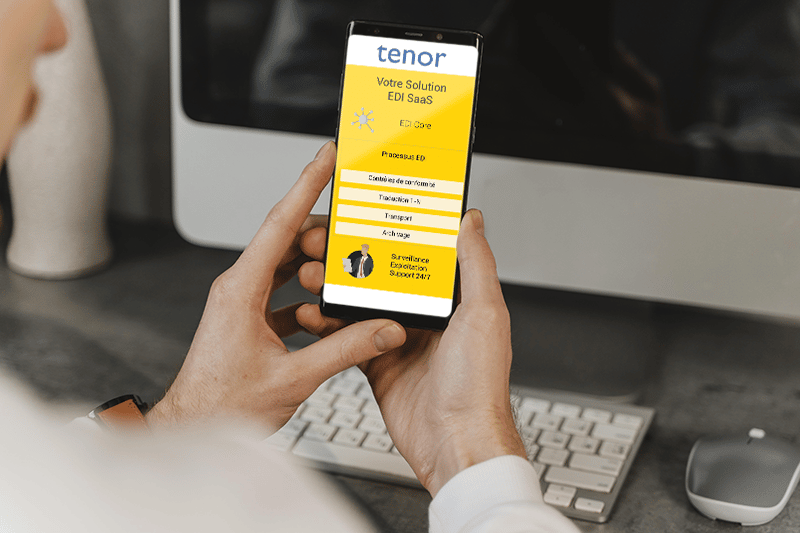How does Mobile EDI improve the efficiency of logistics processes ?
15 June 2023
15 June 2023

Mobile EDI systems synchronize mobile data with corporate business data. The key to the success of mobile solutions lies in their ability to communicate with business applications. Users of mobile EDI applications have real-time access to up-to-date information, and gain in responsiveness and productivity.
Let’s take a look at Mobile EDI and how it compares to traditional EDI. How the logistics sector gains in efficiency by deploying Mobile EDI solutions.
An EDI Mobile solution enables mobile applications to work with EDI data.
Until now, mobile handsets have not been very ergonomic, penalized by the size of their screens. 4G and 5G networks reduce latency times. As a result, mobile applications were limited to basic actions, such as validations and barcode scans. And data exchanges were executed in batch mode when the mobile terminal connected to the corporate network.
With the increasing size of mobile screens, most of which are now touch-sensitive, and the deployment of 4G and now 5G networks, the use of mobile terminals is becoming more fluid and comfortable.
It is now possible to install and use functionally rich applications with clear, legible screens. Bringing more information to their users. And operating online, anywhere.
The technical environment enabling professional, connected mobile applications meets the technical communication requirements of EDI. Mobile EDI solutions are ready to go live.
Mobile EDI involves the exchange of computerized data between corporate IS applications and mobile applications.
Traditional EDI, on the other hand, enables companies to exchange commercial documents. Mobile EDI enables:

Here are two examples:
The Logistics sector is best placed to deploy Mobile EDI solutions and reap the greatest benefits.
For almost 30 years, EDI has been at the heart of the digital transformation of the supply chain. EDI already interconnects all the players in the supply chain: manufacturers, carriers, logisticians, customs, distributors, etc.
An EDI flow accompanies every physical or financial movement. EDI makes it possible to order, trace, locate, deliver, invoice and pay.
Until now, EDI has been used to connect the Information Systems of the various players in the supply chain, i.e. to connect BackOffice applications.
EDI Mobile extends EDI connections from one end of the supply chain to the other. Right down to the operational staff at the end of the chain, i.e. forklift drivers, order pickers, delivery drivers and receptionists.
By equipping personnel at logical platforms or in charge of deliveries with mobile equipment, logistics processes can be digitized. The use of mobile equipment connected to a Mobile EDI solution enables greater reactivity, productivity and traceability.
Barcode, EAN and SSCC scans enable:
The benefits are the elimination of paper, scans of paper documents, and therefore fewer errors, and the feedback of updated data to BackOffice applications.
Traceability is secured and reinforced, and batch number scans prevent any errors. It’s also easy to supplement traceability information with a thermal temperature reading and a degree of hydrometry for products subject to storage conditions.
On delivery, touch-signature functions enable you to attach the recipient’s signature to a delivery note. In the event of a dispute, photos can also be attached.
Mobile application input forms can be used to update business data in real time: number of packages, quantity, change of product reference.
Notifications appear on the screens of users’ mobile terminals to inform them of events such as a new order to be prepared, or an order modification.
The order picker receives the HANMOV message on his terminal, indicating a task to be carried out.
Validations carried out on mobile terminals trigger the sending of EDI messages:
The order is ready and scanned as it is loaded onto the truck, and a DESADV (dispatch notice) is sent to the recipient,
When a stock status is validated, an INVPRT message (inventory status) is sent to the stock owner, etc.
Find the different EDI messages used in transport and logistics.
Mobile EDI is still in its infancy, but two major developments are driving the deployment of Mobile EDI solutions.
The use of mobile terminals, smartphones and tablets, when telecommuting or on business trips, requires connection to a Mobile EDI for logistics-related operations: inventory consultation, order validation, invoicing, etc.
Mobile applications will have to interact via the Internet with a large number of platforms. From Internet of Things platforms to Webservices. This heterogeneity of systems and languages calls for system-independent exchange solutions, with the risk of data fragmentation and the emergence of silos.
EDI is a neutral vector for transporting information. Its nature is to electronically transmit data structured according to standardized messages. It remains independent of languages and operating systems.
A Mobile EDI solution is therefore a secure and proven method of transporting information in SupplyChain 4.0.
Discover our EDI solutions and contact our experts to launch your project today.